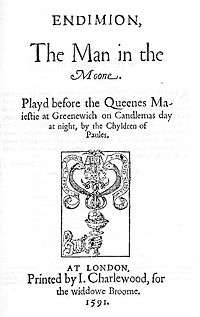Endymion (play)

Endymion, the Man in the Moon is an Elizabethan era stage play, a comedy by John Lyly. The play provides a vivid example of the cult of flattery in the royal court of Queen Elizabeth I, and has been called "without doubt, the boldest in conception and the most beautiful in execution of all Lyly's plays."[1]
Performance and publication
The play's date of authorship is not known with certainty; it was acted at Greenwich Palace by the Children of Paul's, most likely on Candlemas, 2 February 1588.[2] Endymion was entered into the Stationers' Register on 4 October 1591, and was first published soon after in a quarto printed by John Charlwood for Joan Broome (the widow of bookseller William Broome, who had published reprints of Lyly's Campaspe and Sapho and Phao earlier in 1591). It was published again in Six Court Comedies (1632), the first collected edition of Lyly's plays issued by Edward Blount.
Endymion is currently in a state of revival. The 2009 American Shakespeare Center's Young Company produced the first Original staging practices production of Endymion, under the direction of Brett Sullivan Santry, in an estimated 400 years. While the script was shortened, the performance included a cast of noteworthy young American actors including; Ben Lauer as Endymion, Mary Margaret Watkins as Cynthia, and Mariah Webb as Tellus.
A 2012 full production by the T24 Drama Society of the University of Kent took place, directed by Freddy Waller and starring John Davis as Endymion and Holly Morran as Cynthia.[3]
Sources
As the title indicates, the play is based on the classical tale of Endymion; yet its connection with the myth is slight, and the work is mainly the product of Lyly's own imagination and taste. Lyly also seems to have borrowed some hints from the dialogue between the Moon and Venus written by Lucian. Elements in the comic subplot derive from the Italian Commedia dell'arte and the classical Latin comedy of Plautus and Terence.[4]
Synopsis
The opening scene presents a conversation between Endymion and his friend Eumenides, in which Endymion confesses that he has fallen in love with the Moon goddess, Cynthia. Eumenides concludes that his friend is "bewitched" and has lost his senses. Cynthia is predictably cool to Endymion's passion. Tellus, Endymion's former beloved, resents the change in his affections; she hires a sorceress named Dipsas to enchant Endymion into a deep sleep, from which he cannot be awakened. Cynthia learns of this development; the goddess confines Tellus to a castle for speaking harshly of Endymion (she does not yet know that Tellus is the cause of the enchantment). Corsites, the commander of the castle, falls in love with Tellus. Cynthia also sends Eumenides in search of a cure for his friend's magic-induced sleep.
Eumenides is in love with Semele, though she scorns his affections. Eumenides reaches a magic fountain that will answer any one question — but only one question — an inquirer asks of it; he debates whether he should expend his question on his friend's predicament, or his own. His sense of duty triumphs, and the fountain tells him that Endymion can only be awakened by a kiss from Cynthia. The goddess acquiesces, kisses and wakes Endymion. Tellus's treachery is revealed, and forgiven. The play ends with the marriages usual for comedy, with Eumenides, Tellus, and Dipsas all headed to the altar with appropriate mates. Endymion, however, cannot marry Cynthia; as a goddess, she is too far above his station on the mortal plane.
The play also has a comic subplot: Sir Tophas nourishes a foolish passion for the enchantress Dipsas, and he is the butt of the jokes and pranks of the crew of pages that constitute a standard feature of Lyly's drama.
The critical response
It is universally recognized that Endymion is to a major degree allegorical, and that Cynthia represents Queen Elizabeth. Nineteenth-century critics tended to assign other roles in the play to historical figures of Elizabeth's court: Endymion, perhaps, was Robert Dudley, 1st Earl of Leicester, while Tellus was Mary, Queen of Scots.[5] Twentieth-century critics have approached these hypotheses skeptically, arguing that if Lyly had ventured any such bold or obvious commentary on Elizabeth's personal life, his career at Court would have ended quickly.[6] In contrast to historical interpretations, an overtly Christian reading of the allegory has been advocated.[7]
It is generally agreed that Endymion is the one of Lyly's plays that had the strongest influence on Shakespeare, most obviously on Love's Labor's Lost and A Midsummer Night's Dream.[8]
Light on plot, characterization, and dramatic incident, but verbally rich, the play has more to offer a patient reader than a fan of drama. In the view of one commentator, Endymion, "with its radiating central image, its mathematical elaboration, its receding depths, its near motionless and queer timelessness," is "more a contemplation than a comedy."[9]
References
- ↑ Wilson, John Dover. John Lyly. Cambridge, Macmillan and Bowes, 1905; p. 107.
- ↑ Chambers, E. K. The Elizabethan Stage. 4 Volumes, Oxford, Clarendon Press, 1923; Vol. 2, p. 18.
- ↑ http://www.kent.ac.uk/news/homepagestories/students-give-rare-performance/2011
- ↑ Boughner, Daniel C. "The Background of Lyly's Tophas." Papers of the Modern Language Association 54 (1939), pp. 967-73.
- ↑ Wilson, p. 109.
- ↑ Chambers, Vol. 3, p. 415.
- ↑ Bryant, John A., Jr. "The Nature of the Allegory in Lyly's Endymion." Renaissance Papers (1956), pp. 4-11.
- ↑ Wilson, pp. 109-10.
- ↑ Peter Saccio, quoted in: Terence P. Logan and Denzell S. Smith, eds. The Predecessors of Shakespeare: A Survey and Bibliography of Recent Studies in English Renaissance Drama. Lincoln, NE, University of Nebraska Press, 1973; p. 132.
External links
Online version of Endimion - The Man in the Moone in modern spelling.